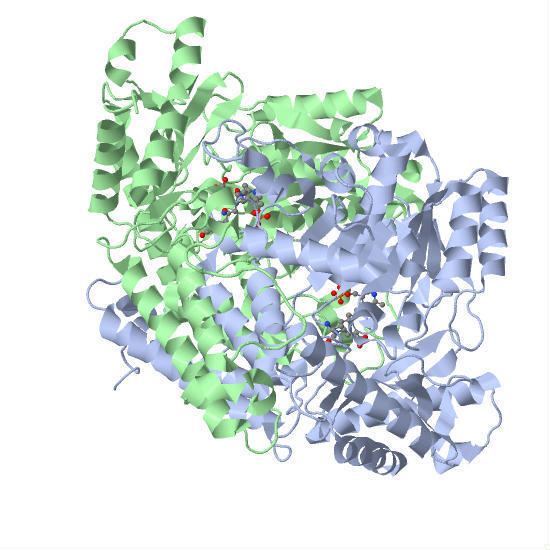EC number 4.1.1.15 ExPASy NiceZyme view | CAS number 9024-58-2 | |
 | ||
Glutamate decarboxylase or glutamic acid decarboxylase (GAD) is an enzyme that catalyzes the decarboxylation of glutamate to GABA and CO2. GAD uses PLP as a cofactor. The reaction proceeds as follows:
Contents
- Regulation of GAD65 and GAD67
- Diabetes
- Stiff Person Syndrome
- Schizophrenia and bipolar disorder
- Parkinson disease
- Cerebellar disorders
- Neuropathic pain
- Other Anti GAD associated neurologic disorders
- References
In mammals, GAD exists in two isoforms encoded by two different genes - GAD1 and GAD2. These isoforms are GAD67 and GAD65 with molecular weights of 67 and 65 kDa, respectively. GAD1 and GAD2 are expressed in the brain where GABA is used as a neurotransmitter, GAD2 is also expressed in the pancreas.
At least two more forms, GAD25 and GAD44 (embryonic; EGAD) are described in the developing brain. They are coded by the alternative transcripts of GAD1, I-80 and I-86: GAD25 is coded by both, GAD44 - only by I-80.
Regulation of GAD65 and GAD67
GAD65 and GAD67 synthesize GABA at different locations in the cell, at different developmental times, and for functionally different purposes. GAD67 is spread evenly throughout the cell while GAD65 is localized to nerve terminals. This difference is thought to reflect a functional difference; GAD67 synthesizes GABA for neuron activity unrelated to neurotransmission, such as synaptogenesis and protection from neural injury. This function requires widespread, ubiquitous presence of GABA. GAD65, however, synthesizes GABA for neurotransmission, and therefore is only necessary at nerve terminals and synapses. In order to aid in neurotransmission, GAD65 forms a complex with Heat Shock Cognate 70 (HSC70), cysteine string protein (CSP) and Vesicular GABA transporter VGAT, which, as a complex, helps package GABA into vesicles for release during neurotransmission. GAD67 is transcribed during early development, while GAD65 is not transcribed until later in life. This developmental difference in GAD67 and GAD65 reflects the functional properties of each isoform; GAD67 is needed throughout development for normal cellular functioning, while GAD65 is not needed until slightly later in development when synaptic inhibition is more prevalent.
GAD67 and GAD65 are also regulated differently post-translationally. Both GAD65 and GAD67 are regulated via phosphorylation, but the regulation of these isoforms differs; GAD65 is activated by phosphorylation while GAD67 is inhibited by phosphorylation. GAD67 is phosphorylated at threonine 91 by protein kinase A (PKA), while GAD65 is phosphorylated, and therefore regulated by, protein kinase C (PKC). Both GAD67 and GAD65 are also regulated post-translationally by Pyridoxal 5’-phosphate (PLP); GAD is activated when bound to PLP and inactive when not bound to PLP. Majority of GAD67 is bound to PLP at any given time, whereas GAD65 binds PLP when GABA is needed for neurotransmission. This reflects the functional properties of the two isoforms; GAD67 must be active at all times for normal cellular functioning, and is therefore constantly activated by PLP, while GAD65 must only be activated when GABA neurotransmission occurs, and is therefore regulated according to the synaptic environment.
Diabetes
Both GAD67 and GAD65 are targets of autoantibodies in people who later develop type 1 diabetes mellitus or latent autoimmune diabetes. Injections with GAD65 has been shown to preserve some insulin production for 30 months in humans with type 1 diabetes.
Stiff Person Syndrome
High titers of autoantibodies to glutamic acid decarboxylase (GAD) are well documented in association with stiff person syndrome (SPS). Glutamic acid decarboxylase is the rate-limiting enzyme in the synthesis of γ-aminobutyric acid (GABA), and impaired function of GABAergic neurons has been implicated in the pathogenesis of SPS. Autoantibodies to GAD might be the causative agent or a disease marker.
Schizophrenia and bipolar disorder
Substantial dysregulation of GAD mRNA expression, coupled with downregulation of reelin, is observed in schizophrenia and bipolar disorder. The most pronounced downregulation of GAD67 was found in hippocampal stratum oriens layer in both disorders and in other layers and structures of hippocampus with varying degrees.
GAD67 is a key enzyme involved in the synthesis of inhibitory neurotransmitter GABA and people with schizophrenia have been shown to express lower amounts of GAD67 in the dorsolateral prefrontal cortex compared to healthy controls. The mechanism underlying the decreased levels of GAD67 in people with schizophrenia remains unclear. Some have proposed that an immediate early gene, Zif268, which normally binds to the promoter region of GAD67 and increases transcription of GAD67, is lower in schizophrenic patients, thus contributing to decreased levels of GAD67. Since the dorsolateral prefrontal cortex (DLPFC) is involved in working memory, and GAD67 and Zif268 mRNA levels are lower in the DLPFC of schizophrenic patients, this molecular alteration may account, at least in part, for the working memory impairments associated with the disease.
Parkinson disease
The bilateral delivery of glutamic acid decarboxylase (GAD) by an adeno-associated viral vector into the subthalamic nucleus of patients between 30 and 75 years of age with advanced, progressive, levodopa-responsive Parkinson disease resulted in significant improvement over baseline during the course of a six-month study.
Cerebellar disorders
Intracerebellar administration of GAD autoantibodies to animals increases the excitability of motoneurons and impairs the production of nitric oxide (NO), a molecule involved in learning. Epitope recognition contributes to cerebellar involvement.
Neuropathic pain
Peripheral nerve injury of the sciatic nerve (a neuropathic pain model) induces a transient loss of GAD65 immunoreactive terminals in the spinal cord dorsal horn and suggests a potential involvement for these alterations in the development and amelioration of pain behaviour.
Other Anti-GAD-associated neurologic disorders
Antibodies directed against glutamic acid decarboxylase (GAD) are increasingly found in patients with other symptoms indicative of central nervous system (CNS) dysfunction, such as ataxia, progressive encephalomyelitis with rigidity and myoclonus (PERM), limbic encephalitis, and epilepsy.
